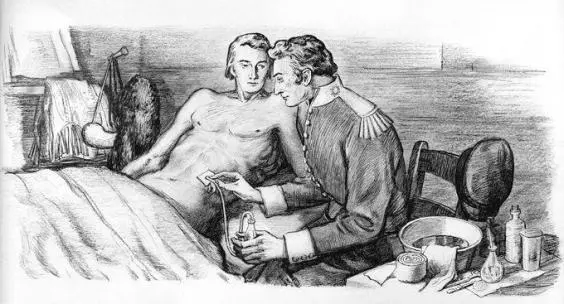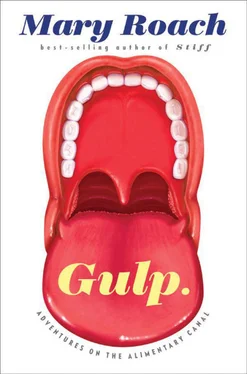Experiment 1 began at noon on August 1, 1825. “I introduced through the perforation, into the stomach, the following articles of diet, suspended by a silk string:… a piece of high seasoned à la mode beef; a piece of raw salted fat pork; a piece of raw salted lean beef;… a piece of stale bread; and a bunch of raw sliced cabbage;… the lad continuing his usual employment about the house.”
On the very first day of his research career, Beaumont’s work dealt a bruising blow to Fletcherism [34] More recently, the digestive action of a healthy adult male obliterated everything but 28 bones (out of 131) belonging to a segmented shrew swallowed without chewing. (Debunking Fletcher wasn’t the intent. The study served as a caution to archaeologists who draw conclusions about human and animal diets based on the skeletal remains of prey items.) The shrew, but not the person who ate it, was thanked in the acknowledgments, leading me to suspect that the paper’s lead author, Peter Stahl, had done the deed. He confirmed this, adding that it went down with the help of “a little bit of spaghetti sauce.”
—seventy-five years before it was invented: “2 p.m. Found the cabbage, bread, pork, and boiled beef all cleanly digested and gone from the string.” No chewing necessary. [35] The Beaumont findings were pointed out to Fletcher in a discussion that followed a lecture of his at a 1909 dental convention in Rochester, New York. “It made no practical difference whether the food was previously masticated very thoroughly, or whether the morsel… was introduced… in one solid chunk,” said an audience member. Before Fletcher could reply, two more doctors chimed with opinions on this and that. By the time Fletcher spoke again, two pages farther into the transcript, the mention of Beaumont was either forgotten or conveniently ignored. At any rate, Fletcher didn’t address it.
Only the raw beef remained intact.
Beaumont carried out more than a hundred experiments on St. Martin and eventually published a book on the work, securing his place in the history of medicine. Textbooks today still make reference to Beaumont, often with hyperbolic phrasing: “the father of American physiology,” “the patron saint of American physiology.” From the perspective of Alexis St. Martin, there was nothing saintly or fatherly about him.
5. Hard to Stomach
THE ACID RELATIONSHIP OF WILLIAM BEAUMONT AND ALEXIS ST. MARTIN


THREE FAMOUS ENGRAVINGS depict Alexis St. Martin in his youth. I’ve seen them many times, in biographies of his surgeon William Beaumont, in Beaumont’s own book, in journal articles about the pair. As detailed as the artworks are, you can’t tell what St. Martin looked like from examining them. All three woodcuts are of the lower portion of his left breast, and the famous hole. I could pick St. Martin’s nipple out of a lineup before I could his eyes. I suppose this makes sense; Beaumont was a researcher and St. Martin his subject—more a body than a man. But the two knew each other across a span of thirty years. They lived together on and off for a decade. Over all this time, did no fondness develop? What exactly was their relationship? Was St. Martin mistreated, or was digesting for science the cushiest job a hard laborer could hope for?
The two first met in June 1822, at a company store on Mackinac Island, part of a trading post owned by the American Fur Company. St. Martin was a French Canadian voyageur—an indentured trapper—hauling pelts by canoe and on foot through the woodsy landscape of the Michigan Territory. St. Martin retained little memory of the pair’s historic meeting, lying, as he was, barely conscious on the floor. Someone’s gun had discharged accidently, spraying a load of duck shot into St. Martin’s side, and Beaumont, the army surgeon assigned to the nearby garrison, had been called down to help.
The ducks of Mackinac Island are apparently not easily taken down. “Found a portion of the Lungs as large as a turkey’s egg protruding through the external wound, lacerated and burnt, and below this another protrusion resembling a portion of the Stomach, what at first view I could not believe possible to be that organ in that situation with the subject surviving, but on closer examination I found it to be actually the Stomach, with a puncture in the protruding portion large enough to receive my forefinger, and through which a portion of his food that he had taken for breakfast had come out and lodged among his apparel.” Thus reads Beaumont’s somewhat windy account of the injury.
Through that puncture—and in the slop of half-digested meat and bread suddenly visible in the folds of St. Martin’s wool shirt—lay Beaumont’s ticket to the spotlight of national renown. Italian digestion experimenters had pulled food in and out of live animal stomachs, soaked it up in sponges on strings, even regurgitated their own dinners, but St. Martin’s portal presented an unprecedented opportunity to document the human juices and processes in vivo. (We will step into the stomach in earnest in chapter 8; for now, it’s medicine’s oddest couple that I wish to explore.)
Beaumont was thirty-seven and on the lookout for something a little glossier than the anonymous rustic toil of an assistant surgeon at a military outpost. Exactly when he realized the value of the St. Martin hole—and how assiduously he did or didn’t work to close it—remain matters of conjecture. The recollection of a man named Gurdon Hubbard, the only eyewitness whose account of that morning remains, suggests the realization occurred earlier than Beaumont claimed. “I know Dr. Beaumont very well. The experiment of introducing food into the stomach through the orifice, purposefully kept open and healed with that object, was conceived by the doctor very soon after the first examination.”
Beaumont denied this. In his journal, he claims to have tried “every means within my power to close the puncture of the Stomach.” I imagine the truth lies midway between. Something closer to Hubbard’s version would serve to explain Beaumont’s puzzling dedication to a man he did not know and about whom he would have been inclined, by birthright, to care little about. St. Martin was a mangeur du lard —a “porkeater,” the lowest class of voyageur. Yet when county funds for St. Martin’s hospital care ran out, in April 1823, Beaumont moved him into his family’s home. The explanation he gives in his journal was that he did so “from mere motives of charity.” That I heavily doubt.
St. Martin was put to work around the house as soon as he was well enough. From the beginning, Beaumont had an eye on the fistula, more or less literally. “When he lies on the opposite side I can look directly into the cavity of the Stomach, and almost see the process of digestion,” wrote Beaumont in his journal. I would love to know how the experimental protocol was first broached. St. Martin had no understanding of scientific method. He was illiterate and spoke little English. He communicated in a French Canadian patois so heavily accented that Beaumont, in his notes from the day of the shooting, transcribed “ St. Martin” as “Samata.” Beaumont kept diaries but neither I nor medical ethicist Jason Karlawish, who has written a fine and sleuthfully researched historical novel about the pair, could find mention of St. Martin’s initial reaction to the unusual proposition.
In “Working Ethics: William Beaumont, Alexis St. Martin, and Medical Research in Antebellum America,” historian Alexa Green explains the men’s relationship as clearly one of master and servant.” If the man wants to push a piece of mutton through your side, you let him. Other duties as assigned. (When St. Martin had healed sufficiently that the premise of providing continuing care began to seem a ruse, Beaumont provided a salary.)
Читать дальше














